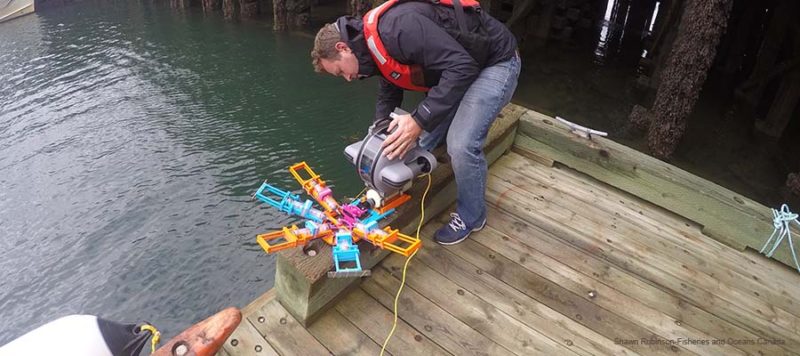Configure Now
Items in Your Cart0
0Items in Your Cart
Start building your packageShop Now
The ocean is an mysterious world which is continuously evolving and altering with currents, climate change, marine life, and other outside forces. Yet, with its monumental vastness, our knowledge of these occurrences and their effects is still limited.
Some of the changes are negatively impacting the surrounding environment, such as the effects of coral bleaching or micro-plastics, but change doesn’t always have a negative impact. For example, artificial reefs can act as new homes to a wealth of marine life and create a new and beneficial habitat.
A senior research scientist with the Department of Fisheries and Oceans at the Biological Station in St. Andrews, New Brunswick, Shawn Robinson is actively engaging in learning how the ocean is changing. One way he is doing this is by monitoring how human interactions are changing what marine life are inhabiting certain areas of interest.

Aquaculture is a prime example where humans are directly interacting with the ocean and potentially altering the landscape, but if this is good or bad is often debated. With the increase in demand for Aquaculture as a sustainable food source for the future, strict regulations and monitoring processes are needed. Some opposition notes that bacteria can develop on the ocean floor; researchers have stated that not all bacteria is bad, however, constant monitoring and testing must be done on the surrounding area to distinguish the types of changes.
Shawn Robinson set out to understand soft-bottom ocean sites with nearby aquaculture farms. His project focused on collecting enough samples to determine what sort of species were living here, what their genetic makeup was, and how this group of species is potentially changing with the development of an aquaculture site. Lastly, they wanted to test how far away from the site these species were living and nourishing on the ecosystem.
The ability to detect what species exist in a certain area without having to visually identify them, has opened up the doors to much more comprehensive research. But, the obstacle still remains of how to best collect these samples in mass and over a longitudinal study in specific areas.
Deploy a ROV to collect samples and gather data for your research
The Deep Trekker DTG2 Worker comes equipped with a manipulator arm which can be outfitted with a syringe feature to collect water or sediment. Although, Robinson was searching for a way to collect multiple samples at the same site, at the same time so they could collect redundancies for their research.

Robinson took it upon himself to design a 3D printed device to accomplish this mission. 3D printing is another form of technology, similar to underwater drones which have recently become more accessible for researchers to purchase and use over multiple studies. Robinson used a free 3D modeling software and was able to create and print many iterations of six syringes in a circle. The design took advantage of the rotating manipulator function on the Deep Trekker ROV, which would open all of the syringes at the same time to bring in the water sample.
The Deep Trekker manipulator provided the exact motion Robinson required to open the syringes because the manipulator could rotate continuously 360-degrees. The syringes could be set to be closed prior to the dive, and when rotated, an attached string would pull all the syringes open.
 Robinson is currently investigating two sites in close proximity to aquaculture farms and has so far collected over 200 samples with the Deep Trekker ROV. Each of the six syringes takes in 50cc of the sediment/water and is then used to distinguish each individual species that is inhabiting that area.
Robinson is currently investigating two sites in close proximity to aquaculture farms and has so far collected over 200 samples with the Deep Trekker ROV. Each of the six syringes takes in 50cc of the sediment/water and is then used to distinguish each individual species that is inhabiting that area.
By using a dive weight at 10 meters (30 feet) on the tether, the researchers deploy the ROV with the weight to send it straight down. This is used as a geo-reference point. From here they know the ROV has a 10-meter radius to collect its samples, and the onboard compass heading provides additional information such as which quadrant they are inspecting to compare to over the longitudinal study.
We at Deep Trekker will continue to strive to provide accessible and commercial-grade tools to expand the abilities of oceanographic research, contact us today to learn how we can help with your next research project >
November 3rd, 2025
At REPMUS 2025, Deep Trekker’s ROVs validated real-world mine countermeasure capabilities...
July 5th, 2025
Deep Trekker’s new Tampa facility brings faster ROV repairs, in-stock parts,...
June 11th, 2025
Equipped with sonar and DVL, Deep Trekker ROVs are helping SES...